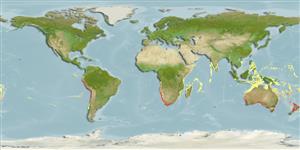Classification / Names
Common names | Synonyms | Catalog of Fishes (gen., sp.) | ITIS | CoL | WoRMS | Cloffa
Actinopterygii (ray-finned fishes) >
Perciformes (Perch-likes) >
Emmelichthyidae (Rovers)
Etymology: Emmelichthys: Greek, emmelyes, -es, -es = harmonious + Greek, ichthys = fish + Greek,ops = appearance (Ref. 45335).
Environment / Climate / Range
Ecology
Marine; bathydemersal; depth range 86 - 500 m (Ref. 58489). Deep-water, preferred 26°C (Ref. 107945); 16°S - 43°S, 13°W - 167°W
Indo-Pacific: Australia, New Zealand, St. Paul and Amsterdam islands. Eastern Atlantic: Off western Cape coast in South Africa, Namibia and Tristan da Cunha. Emmelichthys nitidus cyanescens is found in the eastern Pacific.
Length at first maturity / Size / Weight / Age
Maturity: Lm 20.9 range ? - ? cm
Max length : 55.0 cm TL male/unsexed; (Ref. 115123)
A schooling species (Ref. 9563). Reported from between depths of 86 m (Ref. 58489) and 500 m (Ref. 5325). Juveniles occur near the surface, often with schools of clupeids while adults are found near the bottom in deeper water (Ref. 3394). Adults feed mainly on larger zooplankton (Ref. 3394). An excellent food fish; marketed fresh or frozen (Ref. 3394).
Asynchronous batch spawner with indeterminate fecundity (Ref. 115109). Spawns once every 3-5 days (Ref. 115109).
Heemstra, P.C., 1984. Emmelichthyidae. In W. Fischer and G. Bianchi (eds.) FAO species identification sheets for fishery purposes. Western Indian Ocean fishing area 51. Vol. 2. (Ref. 3394)
IUCN Red List Status (Ref. 115185)
CITES (Ref. 94142)
Not Evaluated
Threat to humans
Harmless
Human uses
Fisheries: minor commercial
More information
ReferencesAquacultureAquaculture profileStrainsGeneticsAllele frequenciesHeritabilityDiseasesProcessingMass conversion
Tools
Special reports
Download XML
Internet sources
